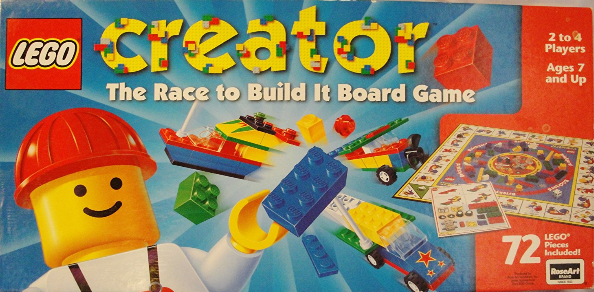 |
| Lego Creator The Race to Build it Board Game |
An oldie but goodie. This game hasn't been manufactured for years and you would probably have to pick it up second hand if you were looking for it. I have never actually played the game with the board, but have been using the game cards for years.
This game came out before the LEGO sets they have now where you can build several small models from one set (LEGO Build Up, LEGO Classic Creative Supplement, etc.) This game includes 20 different models and each game card shows one model.
There are four sets of five cards, identified by the color on the back of each card. All players must use a card from the same color set during a game to make the game work (otherwise there will not be enough of certain parts to go around). The goal of the game is to be the first player to collect the bricks you need to finish your model. When I use this game for therapy, I just bring the cards out and the kids assemble the models. Models include boats, cars, robots, sled, hovercraft, helicopters, and airplanes. All 72 LEGO pieces are the typical LEGOs you find in all other sets and games.
To set up, place the board in the middle of the playing area. Place the LEGO pieces on the board, in the middle circle. Assign a game card to each player. Here is a close up of the board and game pieces.
Players take turns throwing the die and following the instructions on the space they land on. Instructions include pick two bricks, pick one red brick, pick one special piece, and take one brick from another player.
The models on these cards are going to be a little more difficult to build than when building models from LEGOs step-by-step guides. Even though they break each model down into four steps, you will have to add numerous pieces in each step. You will have to be able to look at each new step and see what is new, what has been added. The bottom half of each card pictures the pieces you will need to build that model. As you advance around the board you will pick up pieces that you need and you can place them on the bottom of the card to keep track of what you still need and what you have. The first one to collect all the pieces for his model and assemble it wins the game.
Try this with any LEGO set:
- Give a few minutes to examine the pieces at the beginning so that the person can examine the different shapes and how they snap together.
- Ask the child to choose pieces as they appear in order (in the steps) and assemble the model as he goes.
- Turn pieces on the table so that they can't be picked up by the child in the correct orientation. Ask him to turn each piece in-hand after picking it up.
- Place a piece in the individual's palm, or at the base of the fingers, in the incorrect orientation and ask him to bring it to the fingertips and turn it in-hand for placement.
- Give the beginner one piece at a time while building and point to the piece on the guide to show where it should go.
- Ask the child to pick up the model and hold it in one hand while adding pieces with the other hand so that both hands work together while adding pieces (instead of adding pieces while the model is on the table).
- Show the child how to hold the model with the non-dominant hand while "pinching" the new part on with the dominant hand.
- Place the pieces for each step on the non-dominant side so that the individual will have to cross midline to pick them up. Instruct him not to lean to the side as he reaches across.
- Ask "what is different" at each new step to focus on where the new parts will go.
- Keep the unused pieces in a pile so that the child will have to search for each needed piece. Turn some of the pieces upside down or half cover them so they will look different from the picture.
- Advise the child to hold the model in the same orientation as the one in the picture to aid in orienting pieces.
- Catch mistakes as they happen, as an incorrectly placed piece may throw off the rest of the project. Tell the individual that his model does not look exactly like the picture and see if he can identify the mistake and correct it on his own before jumping in to help.
- Skip the game. Choose a model and find all the necessary pieces, matching them to the bottom of the card. Then use those pieces to build the model.
- Work on executive functions, sequencing, visual discrimination, visual closure, visual form constancy, spatial relations/position in space, visual memory, figure ground, eye-hand coordination, in-hand manipulation, manual dexterity, precise fine motor control, hand arch development, separation of sides of hand, using two hands together, finger strength, social interaction skills, process skills, play and leisure exploration and participation
If you are interested in purchasing this game, you may want to try ebay.


No comments:
Post a Comment
Thank you for taking the time to comment.